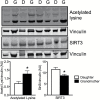Mitochondrial Aging and Physical Decline: Insights From Three Generations of Women
- PMID: 26297939
- PMCID: PMC4675931
- DOI: 10.1093/gerona/glv086
Mitochondrial Aging and Physical Decline: Insights From Three Generations of Women
Abstract
Decline in mitochondrial DNA (mtDNA) copy number, function, and accumulation of mutations and deletions have been proposed to contribute to age-related physical decline, based on cross sectional studies in genetically unrelated individuals. There is wide variability of mtDNA and functional measurements in many population studies and therefore we assessed mitochondrial function and physical function in 18 families of grandmothers, mothers, and daughters who share the same maternally inherited mtDNA sequence. A significant age-related decline in mtDNA copy number, mitochondrial protein expression, citrate synthase activity, cytochrome c oxidase content, and VO2 peak were observed. Also, a lower abundance of SIRT3, accompanied by an increase in acetylated skeletal muscle proteins, was observed in grandmothers. Muscle tissue-based full sequencing of mtDNA showed greater than 5% change in minor allele frequency over a lifetime in two locations, position 189 and 408 in the noncoding D-loop region but no changes were noted in blood cells mtDNA. The decline in oxidative capacity and muscle function with age in three generations of women who share the same mtDNA sequence are associated with a decline in muscle mtDNA copy number and reduced protein deacetylase activity of SIRT3.
Keywords: Acetylated protein; Aging; Mitochondrial DNA; Oxidative capacity; SIRT3; Skeletal muscle.
© The Author 2015. Published by Oxford University Press on behalf of The Gerontological Society of America. All rights reserved. For permissions, please e-mail: journals.permissions@oup.com.
Figures




References
-
- United Nations Department of Economic and Social Affairs Population Division. World Population Ageing. The University of California; 2013;207:1950–2050.
-
- Paffenbarger RS, Jr, Hyde RT, Wing AL, Hsieh CC. Physical activity, all-cause mortality, and longevity of college alumni. N Engl J Med. 1986;314:605–613. doi:10.1056/NEJM198603063141003 - PubMed
-
- Herndon LA, Schmeissner PJ, Dudaronek JM, et al. Stochastic and genetic factors influence tissue-specific decline in ageing C. elegans. Nature. 2002;419:808–814. doi:10.1038/nature01135 - PubMed
-
- Kirkwood TB, Finch CE. Ageing: the old worm turns more slowly. Nature. 2002;419(6909):794–795. doi:10.1038/419794a - PubMed
Publication types
MeSH terms
Substances
Grants and funding
LinkOut - more resources
Full Text Sources
Other Literature Sources

